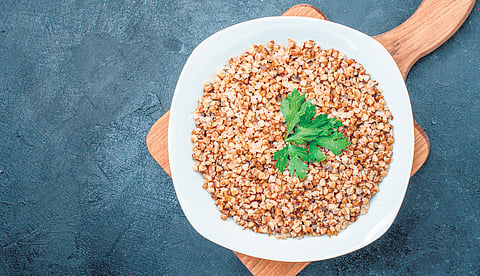

It’s the age of the humble buckwheat. Literally. Domesticated and first cultivated in inland Southeast Asia around 6,000 BCE, the grain has made a comeback in popularity owing to an increasing demand for healthy and eco-friendly foods. Grown in the hilly regions of the country, its appeal lies in being a versatile and nutritious option, particularly favoured by those following gluten-free or plant-based diets. In Indian culinary traditions, it has been integral for centuries, commonly known as kuttu, a popular food during fasting periods. The trend towards exploring diverse global cuisines has boosted its recognition, gaining worldwide popularity.
Contemporary flavours
Most chefs today believe in locally sourced ingredients, innovation and sustainability. Buckwheat, naturally, is a winner. At JW Marriott Mumbai Sahar, Prakash Chettiyar, Director of Culinary, uses it in various forms. “We love showcasing buckwheat’s versatility with dishes like the Buckwheat and Carrot Velouté with Creme Fraîche, a comforting soup with a creamy finish and Buckwheat and Wild Mushroom Risotto with Truffle Oil, which is a unique take on risotto with rich, umami flavours.
Our Buckwheat and Porcini Mushroom Tart with Goat Cheese is hearty and elegant,” he says. The grain is also featured in the fish and chips beer batter, pie crusts, as well as in cookies and pancakes at La Croûte in Delhi. “We like to toast our buckwheat for a few minutes before using it for that extra nutty flavour which complements the creamy filling,” says founder Ipsa Sambhi.
Perfect texture
To make a great buckwheat dish, cooking it the right way is key. The grain takes a bit longer to cook compared to other grains. “Start by rinsing it to remove any dust or bitterness. Then, cook it until tender but still slightly chewy for the perfect texture. For extra flavour, toast the buckwheat before cooking. A splash of lemon juice, a drizzle of olive oil, or even some ghee can make the dish even more delicious,” shares Gaurav Yadav, Chef De Cuisine at The Bombay Canteen, Mumbai.
One must steam buckwheat groats skillfully to cook them best. This method tackles the grain’s need for ample water and guarantees its proper cooking. “Equally essential is the tradition of soaking buckwheat before cooking. It is vital for achieving the intended texture and taste,” adds Gagandeep Sawhney, Executive Chef Shangri-La, Delhi. Buckwheat elevates salads with its nutty taste, unique texture, and health perks. Chef Jaspal of L’Opera, Delhi, says, “Add cooked groats to salads for a protein and fibre boost. Rinse and dry thoroughly to avoid excess moisture. Amp up texture with nuts, seeds, or radishes.”
Mastering a delightful buckwheat dish hinges on grasping its distinctive nature. “Balancing the smoky notes with vibrant herbs and a hint of lime juice takes the dish to exceptional levels,” adds Chef Bhim, Head Chef at Viet:Nom, Gurugram.
Looks like the fascination for buckwheat in fine dining is here to stay.
Bibim Guksu by Chef Prakash Chettiyar
Ingredients
● Soba noodles: 150 gm
● Mixed leaves mesclun: 20 gm
● Pickled cucumber: 5 gm
● Crispy carrots: 10 gm
● Scallions: 5 gm
● Toasted sesame: 2 gm
● Togarashi red cabbage: 20 gm
For the sauce
● Silken tofu: 90 gm
● Sesame oil: 15 ml
● Toasted sesame: 2 gm
● Golden garlic: 10 gm
● White honey: 10 ml
● Mizkan vinegar: 35 ml
● Ponzu: 35 ml
● Kikoman: 60 ml
● Thai red chilli bud (chopped): 8 gm
Method
● Boil soba noodle with seasoned water and keep it aside
● Prepare the vegetables and marinate with salt, fragrant onion oil
● Heat refined vegetable oil and add all the ingredients of the sauce
● Make sure the sauce has a perfect balance of sweet, sour and spice
● Assemble in a bowl